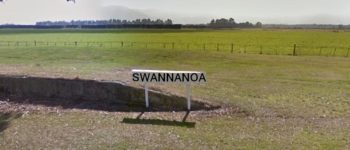1864: Swannanoa
May 7, 2021
By AHNZ
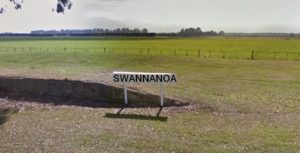 Very rare, very special, that North Canterbury settlement of Swannanoa has a Cherokee name. This is owed to John Evans Brown who carved off a bit of the old Wai-iti Station for his own estate, Swannanoa, in mid-1864. For most of its history, Swannanoa continued to be almost exclusively pastoral; It’s all about the sheep.
Very rare, very special, that North Canterbury settlement of Swannanoa has a Cherokee name. This is owed to John Evans Brown who carved off a bit of the old Wai-iti Station for his own estate, Swannanoa, in mid-1864. For most of its history, Swannanoa continued to be almost exclusively pastoral; It’s all about the sheep.
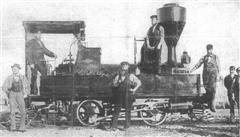 Swannanoa was served by a flag-stop railway station (ie stops to let people off or if someone ‘flags’ the train down) on the old Eyreton Branch line, opened 27 December 1875. This train earned the name “Ohoka Punt” because the land it passed through was so swampy it resembled a boat! The opportunity to train to Swannanoa ended on 26 May 1954 and there’s nothing to mark the spot now on North Eyre Road. Back in 2002 Waimakariri District Council re-erected station nameboards along the ghost line but that left out Swannanoa (the image above is a poorly made fake one adapted from the one at Bennetts by AHNZ.)
Swannanoa was served by a flag-stop railway station (ie stops to let people off or if someone ‘flags’ the train down) on the old Eyreton Branch line, opened 27 December 1875. This train earned the name “Ohoka Punt” because the land it passed through was so swampy it resembled a boat! The opportunity to train to Swannanoa ended on 26 May 1954 and there’s nothing to mark the spot now on North Eyre Road. Back in 2002 Waimakariri District Council re-erected station nameboards along the ghost line but that left out Swannanoa (the image above is a poorly made fake one adapted from the one at Bennetts by AHNZ.)
Swannanoa got chipped away into smaller blocks for family farms over time. Founder John ‘Yankee’ Brown lived an interesting life but writings about him only tough the surface and don’t put the puzzle together from all of his incarnations. I don’t have all the pieces yet but that sort of thing doesn’t tend to get in my way…
John Evans Brown
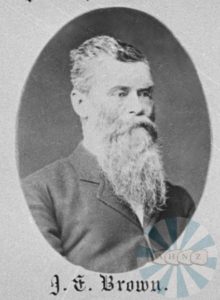 John Brown grew up beside the Swannanoa River in Asheville, North Carolina where his father had large blocks of land. Evidently, Brown the younger didn’t feel welcome in his home territory and he did not settle into it until his father, Major William J. Brown, died in 1884.
John Brown grew up beside the Swannanoa River in Asheville, North Carolina where his father had large blocks of land. Evidently, Brown the younger didn’t feel welcome in his home territory and he did not settle into it until his father, Major William J. Brown, died in 1884.
Brown fled his father and the life mapped out for him for the great outdoors. Rather than be a doctor or lawyer, he became a surveyor helping to open up Ohio to settlement.
One month after is 22nd birthday, Brown went even further by joining the California Gold Rush. His memories have been published in about the most boring account you could ever read about his trip from Asheville to California crossing the breadth of the continent¹.
Brown returned to Asheville for a brief time in the fifties, but in 1856 he sailed from San Francisco for Australia² never to see Brown Snr again.
JEB would soon learn what a winning move he had made to re-locate to New South Wales. Not only did he find a wife, have his children, and make a packet being a sheepman, he avoided the American Civil War. Had Brown stayed behind in Asheville he would have been on the losing side when Stonewood’s Cavalry came, he would have been on the losing side or likely been killed along with his friends. With all the carnage and destruction, it’s a wonder his father, Major Brown, managed to keep hold of enough of his land for JEB to inherit at all.
Yankee Brown Downunder

Any American from the South, to this day, detests being called a Yankee with an above-average intensity, I’ve found. Strange then that the man who was fortunate to avoid his nation’s Civil War should come to be called John ‘Yankee’ Brown in New Zealand. Before moving here in 1864, Brown made a fortune and a family in New South Wales off the back of sheep. His wife’s middle name was even ‘Australia’. Brown became a Commissioner of the Peace in his new Australian home which, I assume, is similar to Justice of the Peace.
Initially, Brown tried to make a go of things in the Queensland interior. For a while there he was the provisional US Consul (1860-62) but this status was revoked/refused by Lincoln’s Union³. Perhaps father back home had pulled some strings to help his son become the legal big-shot he wanted him to be? But the War wasn’t going to allow that to wash now. There was no place for a Confederate son being in charge of a Union outpost during a Civil War. Brown had to find a new gig.
JEB had joined up with a family dynasty called Peacock by marrying (1859) one of their daughters/sisters. For a while things went very well, Brown left behind interior Queensland to farm in the locality we now know as Forbes, New South Wales. Within less than a decade two major things went wrong for the Brown-Peacock operation. For one, mass drought struck Australia which prompted a mass exodus to the likes of Canterbury, New Zealand, where pasture and water abounded. The Canterbury Pilgrims called these new-commer Australians ‘Shagroons’.
The American-Australian-Shagroon, Brown, also quit New South Wales due to a crime problem although just how involved he was is not fully clear.
“Among the articles found by the police was a journal, on the cover of which was inscribed in a good handwriting, “J. Evans, Brown,” an incident of great importance, when it is remembered that the paramour of Gardiner was a Mrs. Brown, and that Mr. Brown is a quiet, respectable man, residing at the Pinnacle or Wheogo. between Forbes and Lambing Flat, and distant about thirty miles from the former.” – The Press (April 1864), Papers Past
“The Gardiner–Hall Gang was an informal group of bushrangers who roamed the central west of New South Wales, Australia, in the 1860s. Named after leaders Frank Gardiner and Ben Hall, the gang was responsible for the largest gold robbery in Australia’s history..” – Wiki
“By 1864 many of the Weddin pioneers had done- the Walshes, Halls, Browns, and O’Meallys. The old had given away to the new in most tragic circumstances.” – Ben Hall Bushranger, D.J.Shiel (1983); University of Queensland

In 1862 the Gardiner-Hall Gang pulled off the biggest robbery in colonial history. In April 1864 the gang members, hiding, brushed up against the life of Brown and his young family. Somehow, JEB’s diary became caught up as evidence in the case against the robbers. So too, had a robust young stockman named John Brown who worked at JEB’s Wheogo sheep station though he seems not to be any relation to JEB.
Young John Brown married one of the Walsh daughters the same way JEB had married into the Peacocks. The Brown, Peacock, and Walsh farmers were all neighbors in the happier time before drought and crime put an end to that and perhaps they all quit for greener pastures when their dirtwater dynasties didn’t pan out. However, John Brown’s wife ran away from him to be with Frank Gardiner just as her sister had run off to marry Ben Hall. Rather than be good farm wives, Mr Walsh’s daughters ran off for a life of crime with the leaders of one of Australia’s most infamous gangs.
The Gardner-Hall Gang tore up the social fabric of the settler families like a scythe. Who needs a drought with lawlessness like this? Mrs Brown never came home, she left Ben Hall for another man and fled to Thames, New Zealand, brutally killing herself at just 25 years old ⁴.
Shagroon and Minister
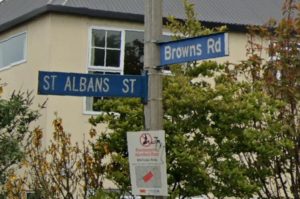 By April 1864, John Evans Brown was in New Zealand. One of the Peacock brothers had been in Canterbury long before even the Canterbury Pilgrims themselves had arrived. After things went south in New South Wales, John Thomas Peacock was able to facilitate the Australian family to follow him to a better land. Swannanoa became established and the Brown family settled down to some stability in their new country. Brown applied to be a naturalised New Zealander, became elected to the Canterbury Provincial Council, and became a Member of the House of Representatives, even a Minister, alongside 3 of the Peacock brothers-in-law. It was a family dynasty that had found a place to stand at last.
By April 1864, John Evans Brown was in New Zealand. One of the Peacock brothers had been in Canterbury long before even the Canterbury Pilgrims themselves had arrived. After things went south in New South Wales, John Thomas Peacock was able to facilitate the Australian family to follow him to a better land. Swannanoa became established and the Brown family settled down to some stability in their new country. Brown applied to be a naturalised New Zealander, became elected to the Canterbury Provincial Council, and became a Member of the House of Representatives, even a Minister, alongside 3 of the Peacock brothers-in-law. It was a family dynasty that had found a place to stand at last.
Brown’s life was turned upside-down again in 1877 when he lost two of his sons in quick succession, followed by his wife who ultimately died of the grief. So it was that, upon hearing of the death of his father back in North Carolina, Brown turned back homeward to pick up his pieces. He left behind Brown’s Road, Papanui, and Chippenham Lodge which became a Social Justice Warrior commune but now derelict.
Golden Slumbers
Back in North Carolina, somehow or other JEB was promoted to Colonel during the time of his second family with a new wife and more children. John Evans Brown discovered his new land was full of mica crystals (perhaps deposited by the Swannanoa River) that would make him rich, or richer! With his wealth, Brown build an epic gothic castle named Zealandia. I believe it has been restored/rebuilt since but given the same name. It has a feature of a special stone access bridge (which is said to be haunted due to a woman killing herself there.)
So, after all the loss and politics and trials of Brown’s life we have a very interesting cultural cross-pollination. ‘Swannanoa’ is a bit of Red Indian, transported to New Zealand from North Carolina. And, ‘Zealandia’ is a bit of Dutch transported from New Zealand to North Carolina.
—
1 Ref. Memoirs of a forty-niner, Brown, John Evans, 1827-1895; Blood, Katie E (1907); The Internet Archive
2 Ref. Frontis W. Johnston, 1979; NCpedia
3 Ref. The Courier, Brisbane (25/8/1864)
4. Ref. Wikitree geneology
5 Ref. Maria Theresa Brown Saumenig, Find A Grave
Image ref. J.E.Brown, William Henshaw Clarke (1882); Cleaned up scratches, AHNZ (2021)
Image ref. Movie poster, The Legend of Ben Hall (2016)
Ref. New Zealand Rail Trails, Mulligan and Cuthbert (2015)
Ref. Eyreton Branch, wiki
 Like Comment Share
Like Comment Share

